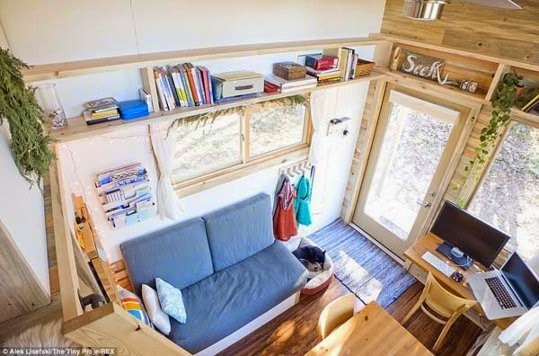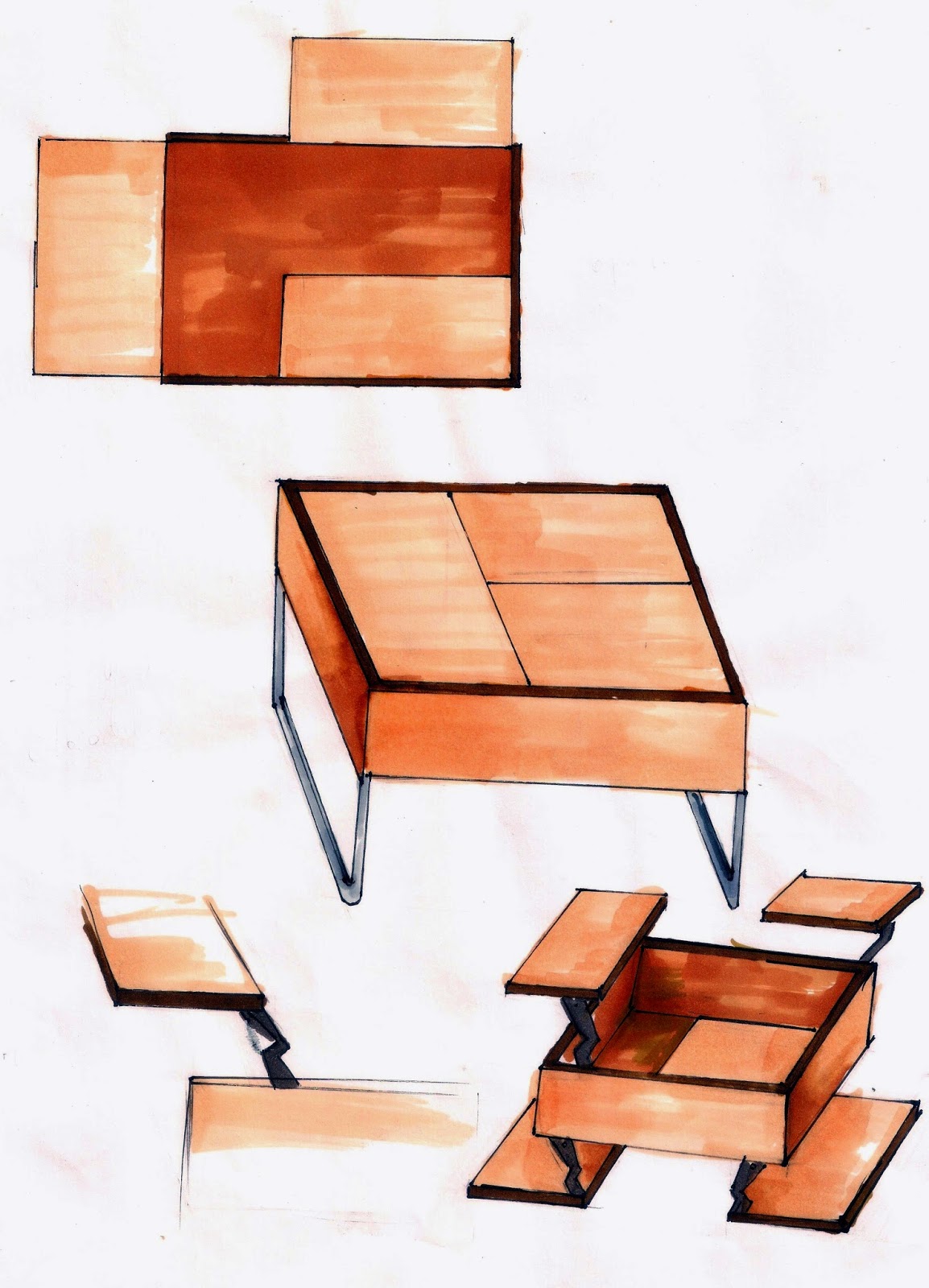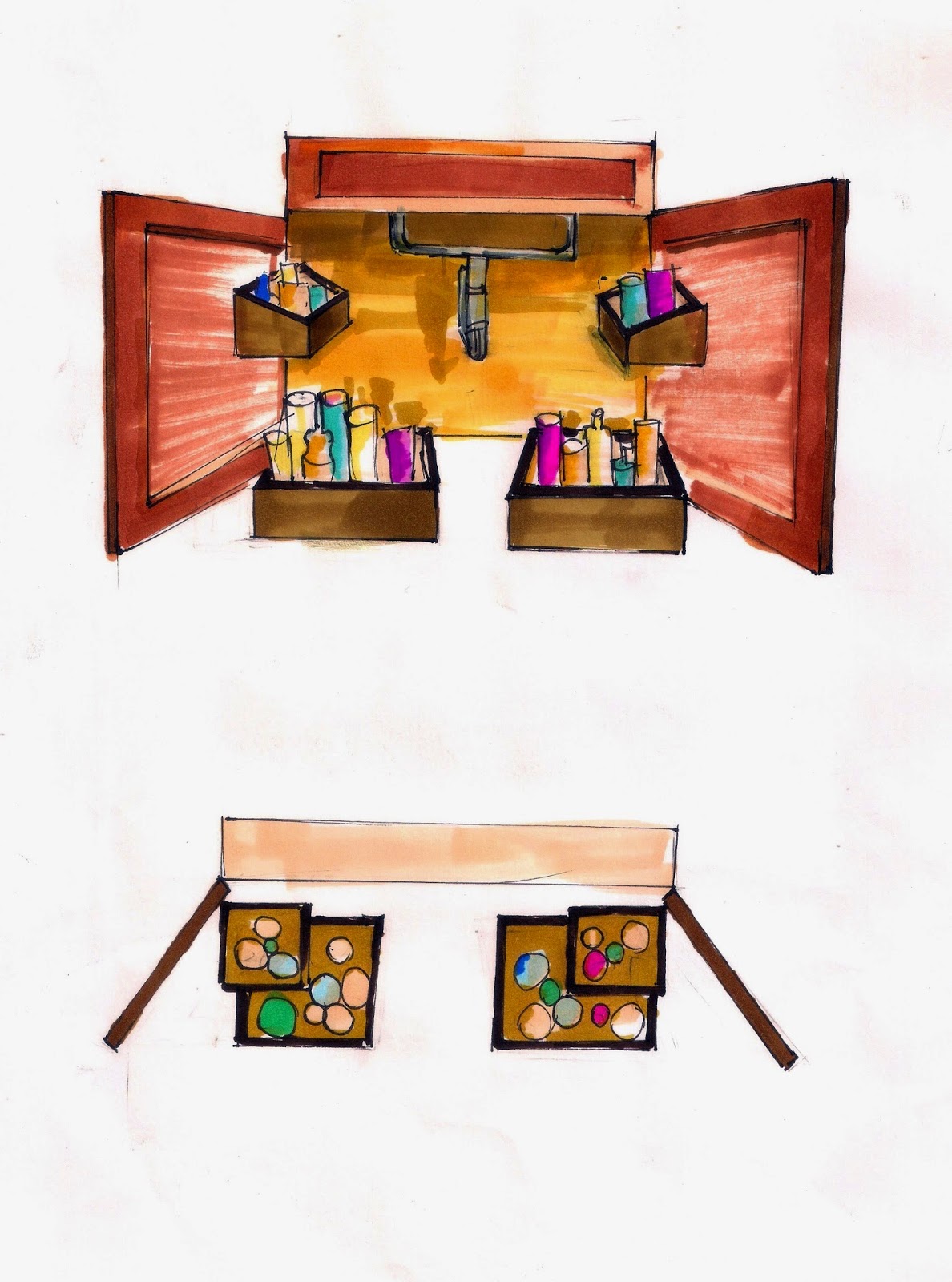Below is an example of how the stuffs can be put higher so that the ground level space can be saved to allow easy movement.
Augustmoments
Thursday 2 April 2015
Design Process - Blog 10 (Ideation & Development of Solution 2)
The second solution is to use vertical space of the living space that is available. Since you cannot maximise the small living space, you can target the top of the house. For example, having a bookshelf at a higher level or a ledge higher up on the wall. Furthermore, it is better to have a rack to hang the pans in the kitchen rather than have more cabinet space so that the pathways can be used to walk freely. It is always good to have things up the walls as they can let you rise your eye level and make the space to seem larger and wider.
Below is an example of how the stuffs can be put higher so that the ground level space can be saved to allow easy movement.
Below is an example of how the stuffs can be put higher so that the ground level space can be saved to allow easy movement.
Design Process - Blog 9 (Ideation & Development of Solution 1)
Our first solution is to make furniture that can fit into small spaces. Below are some furniture that act as many functions for necessary stuffs.
Figure 9.0 Dinning table in different perspective view
Figure 9.1 Bottom of kitchen sink
Figure 9.2 A bunk bed together with study table and a staircase with cabinets
These are some of the furniture that my group has came up with to create less space taken up in small spaces. Firstly, referring to figure 9.0, we come up a table that can store books or any other stuffs inside the table, having the top and bottom of the table to be opened into three sections where people can eat or study on the separated panels. For figure 9.1, we design a bottom sink that has many compartments that can store the necessary items neatly. For figure 9.2, we design a bunk bed with a study table beneath the sleeping area and stairs that have compartments to store clothing or essential items.
Friday 13 March 2015
Design Process - Blog 8 (Analyzing Data/ Information Collected)
Our group prepare a list of questions to cater to our problem solution and also understand how individuals view their life as.
Below are some of the questions proposed that give unique insight into our problem solution...
Referring to the above questions, we want to find out if living space is affecting their daily routines, mental conditions, interaction and so on. After gathering the results, we feel that most people are actually satisfying with their current living space but might also prefer an upgrade of the housing units if they are in good financial status, otherwise, satisfied with current living condition. The reasons are because most do not always stay home all day due to long working hours and going out often. These become a usual sight where most prefer living a smaller space than larger space in the 21st century.
Below are some of the questions proposed that give unique insight into our problem solution...
- How do you find the living cost in Singapore?
- If you are going to own a house, which type of housing would you look for?
- How many people are there in your living space?
- How do you feel about your current living space?
- Do you prefer living in a small space or larger space? And why?
- Have you thought of upgrading your living space?
- Can you afford to upgrade your living space?
- What are some of the issues in your current living space? List out two points.
- Relating to question 11, what would you do to change it? List out two points.
- How do you feel when you come home?
- Is the furniture in your living space organised?
- How often do you spend time at home?
- How often do you clean the house in a week?
- What do you think the government can do to help the citizens live in a better living space? List out two points.
- Do you think you are living in a safe space?
Friday 6 March 2015
Design Process - Blog 7 (Site Study)
We happened to come across this small living space in a bedroom. As you can see from the image below...
Figure 7.0 A small living space of a room
The space in this room is quite cramped and there is only a small area for walking and putting stuffs. There will be not much space left if more furniture are to be added in the room. My group suggest to replace the loft bed with a bed that has hidden compartments for storage of clothing since only one person is using the room. Furthermore, a table that has multi-compartments to store the stuffs and make the table less messy.
Relating to our design problem, we plan to sort out different design methods in making use of small spaces. For example, arranging furniture and storage against the walls or changing hinged doors to sliding or swing doors to save as much space as possible. Also, having mirrored furniture can create double illusion of the space. All these changes definitely make the space more spacious and look less dense.
Friday 27 February 2015
Design Process - Blog 6 (Propose a common + a unique RM that will give you a unique insight into the problem/ solution)
There are different ways in organizing tiny homes. It is never enough or efficient to just reducing the amount of stuffs that you own in your space. There are definitely benefits for living small as you can increase energy efficiency and family bonds.
Living small is the result of being organized and aware of what you own in your surroundings.
The 5 great ways to live in a small space are "Create a floorplan", "Hang stuff", "Slide it", "Multipurpose Furniture" and "Make outdoors your best friend".
The reason is very simple, these methods will only make your small living space significant if they are being followed well. It is never easy to organize but once you start it, it will definitely benefit your living environment and mental condition.
Friday 20 February 2015
Design Process - Blog 5 (Culture & Creativity)
There are debates on whether small living spaces are the current trend or cultural movement. Nowadays, people live in small living spaces and it seems to be growing rapidly. Urban flats have been increasing to suit urban people's lifestyle. As a result, interactivity and sense of community have been lacking and thus becoming a great threat to the society development.
People think of living spaces as the only living room most of the times and do not consider them as a place for great interaction with people around them. Hence, as years go by, people tend to lack of communication and connection with others. All of these contribute to serious society distance. Technology may have help us to venture further but it does not make us connect closer in terms of psychological state in individuals. This can pose great problems in later years.
Hence, it is essential to make use of small living spaces to emphasize on the communication with neighbours.
People think of living spaces as the only living room most of the times and do not consider them as a place for great interaction with people around them. Hence, as years go by, people tend to lack of communication and connection with others. All of these contribute to serious society distance. Technology may have help us to venture further but it does not make us connect closer in terms of psychological state in individuals. This can pose great problems in later years.
Hence, it is essential to make use of small living spaces to emphasize on the communication with neighbours.
Friday 13 February 2015
Design Process - Blog 4 (Case Study)
My group is relating to Hong Kong for our case study to our design problem.
Figure 4.0 Hong Kong's flats
Relating to the above image, it shows how the flats in Hong Kong are organised in a cramp and crowd environment. The reason of having high density development is due to increase of population and highly-priced of land in Hong Kong.
In terms of 'density' and 'crowding', they give different meanings in this issue. 'Density' is often used as the physical limitation of space while 'crowding' is the actual psychological perception of space limitation. Therefore, these issues are becoming big problems to the Hong Kong citizens as they face inadequate income and forced social interaction with one another due to shared flats. Thus, causing stress and mental breakdown to the people. Below is an image of homes that are considered cages to many.
Figure 4.1 Homes consider as “Cages”
In this case, we are looking into solutions to solve the related issues. Firstly, they can improve building management and maintenance for a clean and safe living environment. Secondly, large lobby spaces can be implemented in new building designs to provide greater sense of openness. Lastly, escalators and express lifts can be built to let the people have more accessibility.
High population in Hong Kong results in most of the residents to live in higher-density housing thus, having smaller units. On the other hand, lower density housing has a more larger and spacious living space especially for higher-income households.
In conclusion, having quality living space is important and essential to everyone as this is long term in our daily lives. Rather than complaining about small living space, essential measures like how to make use of small living space in a house provides a better solution for these issues. It is better to change the internal of the living space rather than the landscape of a building.
Subscribe to:
Posts (Atom)

.jpg)
.jpg)
.jpg)
.jpg)

